Country Report: Italy
While the Italian fashion and automotive industries may steal the global thunder, another sector in Italy flourishes beneath the public’s radar. The country’s pharmaceutical industry continues to punche above its weight in many areas and has supported Italy’s national economy through many periods of weakness.
This sponsored supplement was produced by Focus Reports.
-
Report Publisher: Mariuca Georgescu
Senior Editor: Louis Haynes
Project Director: Alina Manac
Editor: Alexander Ackerman
Project Coordinators: Lisa Diericks, Nicholas Laane
Project Assistants: Laurent Pichotzki-Libano, Luis Sancho, Karen Xi
Designer: Carmen Reyes
-
For exclusive interviews and more info, please log onto www.pharmaboardroom.com or write to contact@focusreports.net
A tradition of resilience: Part I
Amongst the myriad of globally recognized luxury brands promulgated by the Italian fashion and automotive industries, another sector flourishes beneath the public's radar. True to form as a national champion, Italy's pharmaceutical industry punches above its weight in many regards and has supported the national economy through many a period of weakness. Following the period of volatility brought on by the 2008 financial crisis, Italy entered a recession during 2011, seeing the economy contract 4.9 percent from the beginning of 2012 to the end of 2014. Meanwhile, Italy's pharmaceutical production increased by 38 percent from 2009 to 2014, driven by a 71 percent increase in pharmaceutical exports, reaching EUR 20 (USD 26.6) billion in exports and EUR 29 (USD 38.5) billion in total production.
As such, "commentaries over the last one-and-a-half years in the nation's newspapers, economic studies and official central bank reports all attribute the return to growth this year to two core economic sectors," according to Massimo Scaccabarozzi, president of the pharma industry association Farmindustria; "the automotive and pharmaceutical industries." Commensurate with its role in helping the Italian economy return to growth in 2015, Scaccabarozzi explains that the Italian pharma industry is "second in the ranking for industrial production [of pharmaceuticals] in Europe after Germany, but number one when ranked by [pharma] production per capita."

This path to the success that the industry is currently experiencing began long before 2009. "The global pharmaceutical industry was born in Italy," affirms Aldo Braca, president and CEO of the internationally renowned oncology CDMO, BSP. "Farmitalia Carlo Erba and Lepetit were among the first pioneering companies about eighty years ago. Unfortunately, they did not receive much backing from the government, so were never able to flourish to their full potential. Nonetheless, these two entities planted the initial seeds for many Italian firms to develop into what they are today. Looking at the history of large-scale global players, such as Pfizer and Roche, many have been linked, in some way or another, to these two foundational Italian companies."

Beatrice Lorenzin, minister of health
Owing to this remarkable heritage, Italy possesses a wealth of experience in pharmaceutical production, a strong culture of excellence in the field, and a robust manufacturing base that has enabled the industry to capitalize on significant growth opportunities in the past seven years. As Minister of Health Beatrice Lorenzin states, "healthcare represents 12 percent of our GDP and we are the second European hub, behind Germany, in both the pharmaceutical and medical device sectors. We could easily become the first, beating the Germans." Nevertheless, the Italian industry's current position might just as easily be lost; as the opportunities fueling this current boom may be transient. These opportunities stem from an indefinite shift in global demand away from low-cost pharmaceutical products and from APIs originating in emerging markets like India and China towards higher quality European sources. At the same time, Italian manufacturers face a reasonable cost profile relative to German, French, and British companies; in part due to the weaker macroeconomic context.

Luca Pani, general director, AIFA
However, without a flagship global player to lead the Italian pharmaceutical industry, the backbone of the industry today remains small to medium sized, often still family-owned, companies. Osvaldo Ponchiroli, CEO of OP Pharma, confirms that, "it is true that there are a number of well-known Italian companies, which are family-owned, that have attained massive success." He attributes this to "in-depth, insider knowledge, accumulated over decades and combined with a strong ingrained aptitude for strategic long-term vision."
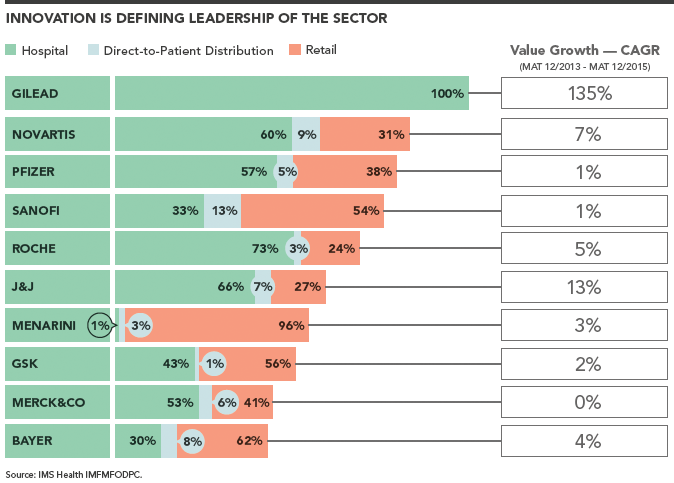
AN UNSUSTAINABLE STORY
Analogous to other EU states, the Italian government is deeply concerned about the long-term sustainability of healthcare spending and maintaining universal healthcare coverage; "hospital pharmaceutical spending is EUR 1.8 (USD 2.0) billion out of control" warns Minister of Health Beatrice Lorenzin. This number may rise due to the large number of high-cost innovative therapies that have recently or will soon be coming to market and the country's ageing population. 21.25 percent of Italians were over the age of 65 in 2014, behind only Japan and Germany.
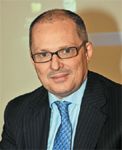
Walter Ricciardi, president, ISS
Yet, thus far, the Italian government has been highly successful at managing costs, with public healthcare spending accounting for 7.1 percent of GDP versus the 7.9 percent average of the 'Big Five' EU countries, and pharmaceutical expenditures as a proportion of GDP roughly 30 percent below those of France and Germany according to Farmindustria. Bloomberg rated the Italian healthcare system the third most efficient in the world in 2014 with an 'efficiency score' of 76.3; Singapore scored 78.6, while France was in eighth as the next most efficient European country, with 64.6.
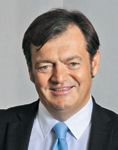
Massimo Scaccabarozzi, president, Farmindustria
As such, Massimo Scaccabarozzi, president of Farmindustria, has been working to communicate that "if you add up what [the pharmaceutical industry] gives back in terms of investments, R&D, salaries, and taxes you get to EUR 13 (USD 14.4) billion," which is quite comparable to the country's EUR 15 (USD 16.6) billion RX market, which has contracted significantly from a peak of EUR 17.2 (USD 22.8) billion in 2010 (IMS data). Prices have similarly fallen, with an average pack costing EUR 9.6 (USD 10.7) in 2015 versus EUR 11.4 (USD 15.1) in 2010. Given these trends and the pharma industry's economic contribution to the country, many industry leaders have argued that the government should stop framing the industry purely as a cost to be contained. Pfizer country manager Massimo Visentin says, "there needs to be a broader shift in attitude towards viewing pharmaceuticals as part of the solution, rather than purely as a cost." Scaccabarrozi has been central in encouraging this perspective shift, and contends, "we have succeeded in changing the government's perception of the industry, and a clear indication of that came in October 2014 when we had a meeting with the Prime Minister... We invited all the CEOs of the major national and international companies investing in the country to this meeting, we met with the Prime Minister, and we made a pact to invest in the country. In return, the government would view the industry not just as a cost, but as an asset to the country."

Paolo Casati, managing director, Santen
Despite improving relations between industry and government; many feel that funding committed by the government for pharmaceuticals is insufficient. Pfizer's Massimo Visentin argues that, "the system today is certainly not sustainable, in particular when you isolate the hospital business which is seeing, and will continue to see, the introduction of the majority of the most innovative and expensive new drugs." There is a limit to the amount the government is willing to spend far below the real demand. "This gap currently stands at around EUR 1.5 (USD 1.7) billion and, considering the fact that the total budget is currently EUR 3.8 (USD 4.2) billion, this demonstrates that the budget is simply not matching the country's needs," he observes.

Giorgio Pisani, general manager IBSA
The situation is complicated by the fact that Italy has "silo budgets in healthcare, which means that whatever is saved in hospitals cannot be redirected towards the pharmaceutical sector," according to Amgen general manager, Francesco di Marco. As such, he says that while "it is true that highly effective drugs do generate savings in the hospital sector, unfortunately Italy's healthcare system is not currently structured in such a way as to be able to take advantage of this." Leo Pharma's general manager Paolo Cionini notes that, "different regulatory authorities have different budgets and concerns. For instance, AIFA is only responsible for pharma products, so they focus on drug prices. But there are interactions between all elements of the healthcare system, for instance, an efficient drug may lower hospitalization costs, and this needs to be taken into account in the drug pricing and reimbursement process." Marco points out that the nature of hospital and pharmaceutical costs are very different and, when the government is working to meet budgetary targets, "it is very difficult to close a hospital while it is much easier to introduce measures such as our current payback system where we pay back around 50 percent of the budget overruns incurred as a result of overspending. Unfortunately, this does not only put a cap on the system's expenditures, but also on innovation, as well as to patients' access to it."
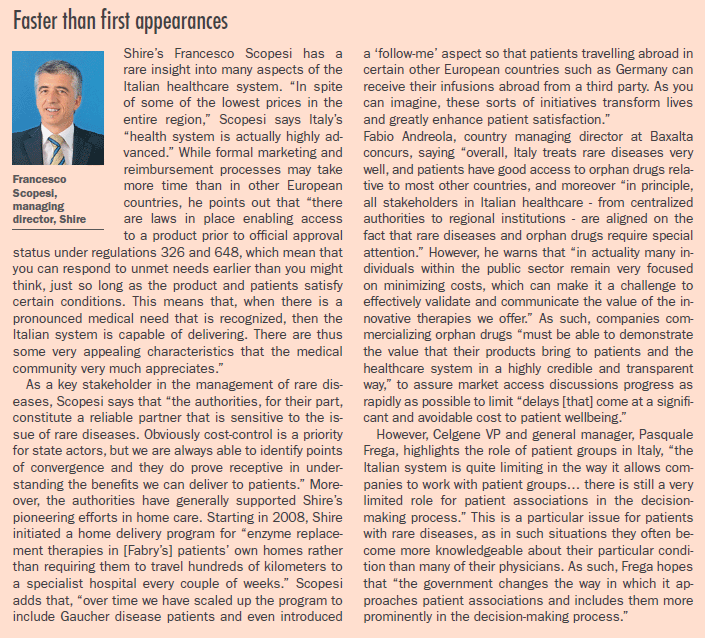
This payback system has become a bone of contention between the pharmaceutical industry and the government and is now a major consideration for potential investors. Boehringer Ingelheim's country president, Anna Maria Porrini, says that she "can understand" the rationale behind the government trying to contain costs and bring health expenditure under control, but notes that "this mechanism where we pay for part of the expenditure naturally makes us think long and hard about continuing to invest in the country." "If we have to repay a certain amount of money, that means that we cannot use that money to invest. This is quickly becoming a vicious cycle, which we feel must be broken soon," she adds. Pfizer's Visentin recalls that working with the government to find new solutions has become a key priority, so much so that a there was a "meeting between our CEO, Ian Read, and Prime Minister Renzi and Minister Lorenzin last September, in which he discussed the need to find an alternative to the current payback mechanism that places the country in such an unfavourable position compared to other more competitive European markets."

Leonardio Vingiani, director, Assobiotec
Given the relative scarcity of public funding for pharmaceuticals, many innovative stakeholders have actually begun to encourage the use of generics and biosimilars, which currently account for only 20 percent of market value and 50 percent of volume. Leonardo Vingiani, director of Assobiotec, argues that, "it is vital that we save money through generics, in order to finance innovation [and] without these savings, we will not be able to innovate sufficiently to effectively maintain our traditional standards of healthcare." Novartis's global strategy corresponds directly with Vingiani's argument. As country president Georg Schroeckenfuchs points out, Novartis offers "high quality generics through Sandoz and leadership in biosimilars as well. This allows us to contribute proactively to the establishment of an overall more sustainable healthcare system. The generics and biosimilars that we provide can go towards freeing up resources that can then be reinvested in real innovation."

Francesco di Marco, managing director, Amgen
According to a study commissioned by Assogenerici, as much as EUR 1.4 (USD 1.6) billion in retail spending could be saved through the wider use of generics in Italy. These savings would however go to consumers and would not directly impact public budgets. Generics and biosimilar penetration in hospital channels may lag behind some other European markets, but Accord's managing director Massimiliano Rocchi explains that for the "traditional chemotherapies, the market-share in terms of volume varies from 60 percent for Epirubicin to 100 percent for fluorouracil. All the rest fall somewhere in this range," and for the hospital market in general "volumes and consumption are flat and the price is declining due to competition." He further explains that "today, the adjudication process [for tenders] is one hundred percent based around price," but that this should be changing as EU directive 24/2014 "states that hospitals should change this to be compliant with the 'Most Economically Advantageous Tender' process," which will theoretically encourage hospitals to offer the best value, not the lowest price.

Fabio Andreola, country managing director, Baxalta
Given the unsustainability and costs of attachment to branded products, the situation is evolving. Osvaldo Ponchiroli, CEO of OP Pharma, notes that "the Italian generics market has seen double-digit growth in the past decade... [and] this growth is set to continue. Generics penetration is still low in Italy compared to other European countries, and given the unrelenting budget constraints, the generics market will only continue to grow, as these drugs represent a critical element of the solution to the problem of maintaining budget sustainability."

Unfortunately, an attachment to original pharmaceutical products is not the only inefficiency within Italian healthcare. For one, there is significant room for improvement in preventative healthcare; according to MSD Italy's CEO Nicoletta Luppi, "the WHO has been very severe with Italy, as coverage among the population is falling rapidly." For MSD, she says, "our first objective therefore needs to be to help the authorities to get coverage rates up to the required standard. Approval of the National Vaccination Plan is the best way to do this, especially considering its relatively low expense compared to the large costs which could be avoided through its effective implementation."

Eugenio Aringhieri, CEO, Dompe
Professor Walter Ricciardi, president of the Italian National Institute of Health (ISS), highlights that, in the battle for managing costs in healthcare, one of Italy's greatest assets is not being fully utilized. Much like the budgetary situation, "the data we provide is being used in silos, so the Ministry of Finance is using our financial data, while the Ministry of Health is using the data on healthcare indicators." As such, while the ISS has "plenty of data, our system is severely underestimated, undervalued and underused," and he asserts that "we need to start breaking down these silos in order to gain new insights on the state of the healthcare system, and so provide decision makers with the appropriate tools to make smart decisions."

Paolo Zambonardi, managing director, Ferring
In essence, the pharmaceutical industry has made clear progress in cutting costs of innovative drugs in recent years, with total RX expenditures actually decreasing. As Pfizer's Visentin puts it "saving in pharmaceuticals while hospital sector costs continue to spiral out of control will not be sustainable, or correct." That said, Italy clearly possesses the tools needed to improve operational efficiency within the national healthcare system, and current healthcare spending efficiency is already respectable within Europe.

THE MAMBO ITALIANO
Part of the prestige attached to the "made in Italy" brand stems from the sheer level of creativity and attention to detail of Italian workmanship. End consumers may not have reason to wonder where this lauded Italian flexibility and creativity derives from, but those more familiar with the country witness a culture that prides elaborately creative, intricate, and sometimes convoluted methods over a simpler path.
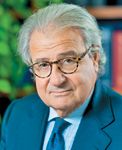
Enrique Häusermann, president, Euro Generici (Stada)
The Italian market access scenario for pharmaceutical products provides a fitting example. Professor Luca Pani, director general of the Italian Medicines Agency (AIFA), recounts that AIFA "was originally established with the idea of calculating the risk-benefit and benefit-to-price ratios of new drugs within the very same institution." A sensible and eye-catching model that "differentiates the Italian regulatory apparatus from its equivalent European counterparts." For Pani, this "ability to fully negotiate the national registration for a drug 'under one roof' has become a real asset, rendering AIFA the sole negotiator for public reimbursement." Unfortunately, the situation is not quite that simple. As Ferring Italy's CEO Paolo Zambonardi details that, "right now, once approval is secured from the EMA, it takes a further six to nine months to get a decision of pricing at the national level before then going to the 21 different regions each with their own peculiarities and distinctive health systems." Some regions are faster than others, ranging from a matter of weeks up to two years. Zambonardi concludes "the end result is a loss of approximately two years patent and today that results in big damage to your profit margins but, more imporantly, it is a problem for the patients who do not have access to innovative products to treat their diseases while they wait."

Massimiliano Rocchi, managing director, Accord Healthcare
Professor Walter Ricciardi of the Italian National Institute of Health (ISS) explains that this anomalous situation arose out of ill-thought-out modifications to the national constitution back in 2001. "Essentially, the provision of healthcare was delegated to the country's 19 regions and two autonomous provinces, and the state did not retain sufficient competencies to maintain a homogeneous, effective and efficient system in the country." Instead, as Ricciardi puts it, "heterogeneity proliferated, resulting in a wildly imbalanced public health landscape with certain regions blessed with world-class care, while others languish blighted by dysfunction." In his eyes, "the only way to ensure the country's continued ability to maintain universal coverage is to refashion the governance model." Such an eventuality may soon reach fruition with constitutional amendments already under discussion in parliament, which would ultimately require ratification by referendum later in the year.
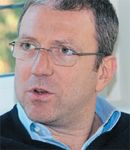
Federico Seghi Recli, managing director, Molteni
IMS managing director Sergio Liberatore has another perspective on the complexity of the Italian pharmaceutical market. As he explains, "the entire marketplace is much more granulated than in many countries," and is served by 240 wholesalers alongside direct sales between some pharmaceutical companies and pharmacies, "and that translates into a high demand for connecting up the dots, which happens to be our specialty." Liberatore admits that "the complexity of the Italian marketplace creates a lot of work for us," and as such, while Italy has the seventh largest pharmaceutical market worldwide, IMS Italy is in fact the third ranked affiliate within the IMS global organization.

Alberto Chiesi, president, Chiesi
Given the fact that getting market access for a product nationwide can require 20 sets of negotiations, one with each of AIFA and the 19 regional authorities, foreign companies must enter the market with a careful approach. Simona Falciai, general manager for Shionogi's recently established Italian affiliate explains that the company started building their European "base in 2012, primarily focusing on developing and registering innovative medicines for the European market, focusing on Germany, Spain and Italy." Falciai notes that "Italy is one of the most challenging countries for market access policy," but contends "AIFA has made important improvements, the timing for centralized approved drugs is much faster now. If you want to have reimbursement, it naturally takes longer to go through the reimbursement process, but the timelines for reimbursement have also been shortened from roughly over a year to six to nine months nowadays. I think a remaining challenge is the predominate regionalization in Italy." With these remaining challenges, Falciai says that "we will focus on women's health in the first few years of our presence while working on the clinical research and market access strategy for our new specialist pipeline," including one very promising product that Shionogi expects "to launch in 2020, but we need to start now with our market access strategy to understand what will be required from the payers in order to get optimal access to this drug."

Massimo Visentin, managing director, Pfizer
Another Japanese company, ophthalmology specialist Santen, is in a similar position with regards to their entry into Italy. General manager Paolo Casati explains that "Santen entered the Italian market being entirely focused on glaucoma," and the company will be "expanding our portfolio in a smart way," by first building "a strong portfolio in ophthalmic pharmaceuticals as a foundation for the affiliate." This strategy is "especially relevant as we have four new ophthalmic treatments arriving over the next few years, and three of those address unmet needs." As such, Casati is "working to establish the brand of Santen" in Italy as "one of the very top companies of reference in our area... especially in terms of relationships with KOLs and the scientific community," although it's clear that the global brand is already known in Italy as "a customer survey showed that most of the KOLs in Italy knew Santen before we arrived in the market." Once Santen Italy establishes itself as a key player in ophthalmology, Casati will begin "looking at the introduction of a wider, more diversified portfolio over time."

Sergio Liberatore, managing director, IMS Health
Although Daiichi Sankyo has been established in Italy for several years, Antonio Reale, CEO of the Italian affiliate, has also had reason to refocus as the company's global R&D focus has shifted from primary to specialty care, with the first such innovative product, Edoxaban, expected to launch soon. Reale explains that due to this shift, "we decided in 2013 to move away from the traditional "push" marketing model to a "pull" model, driven by the needs of our stakeholders. Specifically, it meant switching from a largely tactical approach to a strategic mind-set and to implement a new, more agile and flexible structure better able to respond quickly to all the external changes and challenges." According to Reale, the key aspect of this transformation "was the decision to build the new market access team from the ground up," and to focus "on attracting and recruiting capable resources from the outside" for these roles, because the organization "desperately needed to obtain expertise in this new area."

Fabrizio Greco, managing director, AbbVie
MADE IN ITALY
Regardless of external challenges, the Italian pharmaceutical industry is clearly equipped for success, in terms of physical capital, expertise, and culture. To start with, Italy already has a reputation for quality and workmanship upheld today by luxury automotive and fashion brands, which can be traced to the country's centuries of experience producing wines, olive oil, and leather of the finest quality. AIFA's Pani affirms that "there is a "Made in Italy" element in pharmaceuticals which is just as significant as it is in cars for Ferrari, or in leather for Gucci. We are incredibly good at using numerically controlled machines, such as those used in pharmaceuticals, and there is a very strong SME network in the country. The quality of the drugs these companies make is outstanding, accurate up to 99% and passing every external test." Recipharm Italy's CEO Giorgio Bruno concurs, going so far as to say that, "the Italian stamp is important for our success and our reputation at the international level."

Paolo Marcucci, CEO Kedrion
Signalling the quality and technical sophistication of Italian pharmaceutical manufacturing is the presence of several multinational facilities producing highly innovative drugs for the global market. Georg Schroeckenfuchs, Novartis country president, illustrates this fact by saying that "in the cardio-metabolic therapeutic area we have a standout product in Entresto, which has attained great success in treating chronic heart failure. Interestingly our worldwide production of this particular product is carried out here in Italy and demonstrates our local competitiveness in manufacturing vis-Ã -vis other Novartis manufacturing sites worldwide." Novartis' generics division Sandoz also has facility in Roverto, which had "an export budget of USD 113 million in 2015," and, according to Sandoz managing director Manlio Florenzano, is "dedicated to to the production of API (Acid Clavulanic, Acid Mycophenolate and Tiamulina)." Moreover, Florenzano reiterates that "as part of our long-term strategy we continue to upgrade and modernize our facilities: in 2015-2016 alone, EUR 5 (USD 5.5) million was invested in technological innovation to ensure the highest standards of quality."

Simona Falciai, general manager, Shionogi
Other big-pharma and big-biotech players with significant manufacturing presences in Italy include GSK with two facilities, Pfizer with four following the integration with Hospira, a Lilly facility which produces a third of the company's global insulin supply, and Boehringer Ingelheim. Boehringer Ingelheim president Anna Maria Porrini explains that the company's manufacturing presence in Italy is through subsidiary "Bidachem SPA, which manufactures APIs and plays an important role in the provision of our innovative drugs. It is considered a strategic production site by the Boehringer Ingelheim group and as such we invested EUR 70 (USD 90) million back into the plant in the past five years, and continue to invest around EUR 10 (USD 11.2) million each year in order to keep the facility up to date." AbbVie's Italian manufacturing plays a similar role within that organization, as general manager Fabrizio Greco notes, "the Campoverde manufacturing site has been chosen as the global production site for one of the three active ingredients in our revolutionary treatment to eradicate Hepatitis C. The AbbVie interferon-free therapy against hepatitis C is an important research milestone that can improve the lives of 160 million patients worldwide. All these elements position our manufacturing site as one of the highest performing and most competitive in the AbbVie manufacturing landscape." Similarly, Baxalta country managing director Fabio Andreola explains that "our plant in Rieti is a state-of-the-art plasma fractionation plant that has been expanded significantly over the last few years, supplying other Baxalta worldwide with plasma, to process into branded plasma-derivatives. In terms of technology, this site is quite advanced even within the context of Baxalta's innovative global manufacturing network."
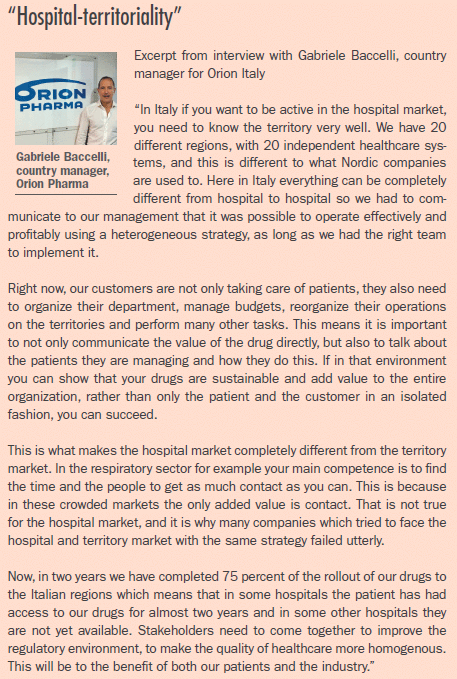
Italy is also home to an assortment of internationally competitive CDMOs that work closely with these leading multinationals. Aldo Braca's BSP is one, as, from the time he founded the organization, "our key objective was to be a CDMO which specializes in a particular segment... we wanted to carve out a specific segment of the market for ourselves." Citing the global pharmaceutical industry's shift from cardiovascular products toward oncology in the last decade, Braca explains that BSP offer their clients "a strong value proposition ... because we solve one of the major challenges of the conjugation process," within their highly specialized oncology facility at, so specialized that outside engineering groups are not allowed within the facility, as according to Braca "we consider our plant to be intellectual property." The focus for the CDMO is currently on the construction of two new immunotherapy plants that they aim to have operational by 2019.

Georg Schroeckenfuchs, country president, Novartis
Leading global CDMOs including Patheon, Catalent, Famar, and Latina all have at least one facility in the country, while Sweden based Recipharm now operates four facilities in Italy following their acquisitions of the Corvette Group and Mitim in October 2014 and February 2016 respectively. Recipharm's Bruno explains that what his clients look for in a CDMO "partner is quality, efficiency, capacity and reliability. The price is important of course but it is not the most crucial factor. Flexibility is key because clients routinely face market fluctuations and they expect us to be able to act and react accordingly." Italians, he says, "place a great emphasis on flexibility. This is why Italian CDMOs in general have a great reputation around the world. We are very flexible in catering to the needs of our customers." Between reputation, expertise, and hard work Recipharm Italy is clearly doing something right, as Bruno admits that "at the moment, we operate with full capacity in all plants that belong to the Recipharm umbrella in Italy â from Biologici to Mitim."
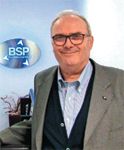
Aldo Braca, president & CEO, BSP Pharmaceuticals
BALANCING AT THE PRECIPICE
With a stellar reputation and the highest pharmaceutical production per capita level in Europe, the Italian industry currently holds a strong position within the global pharma industry. However, several industry stakeholders have voiced concerns regarding the sustainability of prevailing strategies. Despite emerging markets having been a key growth market for many Italian manufacturers in recent years, Alberto Chiesi, president of Chiesi reflects that, "further development will pose a challenge as these economies naturally evolve to drive an economic protectionist policy, usually raising local content requirements." "The consequence is either delocalization of manufacturing capabilities or concluding agreements with domestic manufacturers to license out production," he predicts. Meanwhile, Leonardo Vingiani, director of Assobiotec, raises different concerns pertaining to small molecule products, fearing that, "in five to ten years, our exports of pharmaceutical and medical products, which are currently at record levels, will disappear as emerging markets such as India and China catch up in the quality of their own production." "Biotech products are much more difficult to produce, and this is where our future on the international export stage will be found...Now is the time to be investing in the development of these capabilities," he counsels.

Antonino Reale, managing director, Daiichi Sankyo
As such, for Italy to remain a relevant global pharma production hub, significant additional investment will be needed. Unfortunately for Italy, past success and a tradition of pharmaceuticals alone may not be enough given the competitive financial incentives offered in many jurisdictions. As Pfizer's Massimo Visentin notes, "Headquarters looks at countries as a whole, and for Italy that means they base their evaluation on both the production and commercial side as a single organization." Thus, the potential of the local market, and the extent to which innovation and investment is rewarded, may play a significant role in determining the future growth of the Italian pharmaceutical sector.

Paolo Cionini, managing director, Leo Pharma
Italy's regulatory environment can sometimes place Italian firms at a competitive disadvantage in international markets, a fact that certainly decreases Italy's ability to compete for investment. Kedrion's CEO Paolo Marcucci explains, "our regulations are often fundamentally different to the rest of Europe," and "there are peculiarities that make Italy very complicated and businesses more expensive to run." For example, he recalls that, "to obtain an import permit to Italy for an intermediate from plasma manufactured in an FDA approved plant, normally takes between 12 and 15 months," while "companies in other countries that are achieving exactly the same in a matter of days." Marcucci concludes that, "this is simply not conducive to managing an industrial business."

Nicoletta Luppi, managing director, MSD
However, Marcucci is quick to make clear that "despite the bureaucracy, restrictions and import delays and external competition, there is a lot of knowledge embedded within Italian suppliers, technicians, and R&D. In a relatively small space in Tuscany, we have three high-ranking universities that are focused on medicine, pharmacy and biotechnology, which are attracting a lot of students from all over Italy... It is decidedly appealing to be part of such an environment." Still, "It would be so much easier if the bureaucracy were better aligned with the industry needs and modus operandi."

Giorgio Bruno, general manager, Recipharm
STAYING AHEAD OF THE GAME
There is a palpable degree of inspiration and vision throughout the Italian pharma manufacturing sector that distinguishes the executives leading Italian companies and affiliates. The strong desire to maintain the level of growth and success that has been enjoyed over the last seven years, and the pressure to remain a vibrant source of growth to support the national economy, all appear to play a function in stimulating the famed Italian propensity towards flexibility and creativity. Nonetheless, while Italian executives face the same challenges created by the same global trends as their colleagues do in other markets, a surprising majority seem to have clear and decisive ideas about what they are going to do to stay ahead.

Mario Marazziti, president of the XII Social Affairs Commission, Chamber of Deputies
Eugenio Aringhieri, CEO of Dompé has demonstrated decisive leadership more than anyone else in the industry. As he explains, "it became very clear to me that the pharmaceutical industry is splitting off into two very different directions and that the industry's main protagonists will have to choose one path or the other. There can be no middle ground or third way. Either your leadership relates to your capability to offer the best price and to outcompete your competitors by offering an equivalent performance at a lower cost. Alternatively, you can go down the route of leadership through your capacity to innovate and be the first mover in bringing latest generation technology to market." Given this situation, he had to decide which route would be most successful for Dompé, a traditional Italian family company that in Aringhieri's words was "a local, primary-care orientated company connected by commercial alliances." Pivotally, Aringhieri concluded that the way forward for Dompé would be "leadership through innovation," and thus today he is "in the midst of transforming Dompé from a local pharma company to an international biotech entity."
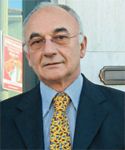
Osvaldo Ponchiroli, CEO, OP Pharma
Dompé is far from alone in this shift towards innovation, as Leonardo Vingiani, director of Assobiotec, says that over "the last six years, we have had an important shift in the image of innovation as a driver of our country's competitiveness. This is something new for Italy, and it has a lot of implications, in the attitude towards research, towards innovation and innovative products and in the public's perception of patents." Vingiani further explains that, "the magnitude of this shift can be seen through the number of companies which have joined our association, which thrives on innovation. In 2009 we had roughly 70 members, today we stand at more than 140."

One such member is Kedrion Biopharma, a globally competitive leader in plasma derivatives. CEO Paolo Marcucci explains that the firm's 15 percent annual growth rate has been "driven by hyperimmune globulins, for which we are leaders in the US and worldwide. Kedrion is internationalizing its business by building a new "a new plant dedicated to the production of a 10 percent immunoglobulin that will be launched in 2020" in the US, but Italy will continue to be central to the production of their most advanced products; "our production sites in Hungary and in the US carry out the relatively easy first part of the fractionation process, whereas the complex, high-value purification step takes place in Italy."

Luca Guidotti deputy scientific director, San Raffaele Scientific Institute
For many mid-sized Italian firms, successfully innovating in life sciences is becoming increasingly challenging. Aside from the rising average cost of bringing an innovative drug to market, Aringhieri highlights that while "traditionally R&D has been performed in-house within the larger firms," today "the sheer complexity of innovation today demands a wholly different approach. We're talking about mastering the arts of nanotechnology, biotechnology, genomic and proteomic systems and much more. Not even big pharma can aspire to cover all of these bases within their own laboratories. It's simply neither economically nor organizationally efficient." Thus, for Italian firms with less access to capital than big pharma, successfully innovating requires new strategies.

Luigi Naldini, director, Telethon Institute for Gene Therapy
The key to these new strategies lies in "the rapidly developing nexus between networking and innovation within the pharma industry," according to Aringhieri. He says "it's far better to develop real mastery in a specific competence and to blend that with a strong network linking you in to the best specialists in all the other fields relevant to the technology that you are innovating," and as such his priority for Dompé has "been to link up our own in-house capabilities with best-in-class actors all around the world by building up and maintaining a formidable network of partners."
Partnerships and collaboration have proven equally important for developing successful and competitive incremental innovations. Molteni CEO Federico Seghli Recli, says that for his company, which "ranks among the largest manufacturers of opioids pharmaceuticals in Southern Europe," the "strategic direction is to accelerate internationalization in the niche market of drug addiction where there is still a clear room and opportunity for a pan-European player." He explains that from 2008 Molteni started working "with Archimedes (now a subsidiary of the ProStrakan Group)" to develop a fentanyl nasal spray; the two companies worked together "on conducting the regulatory trials, and had the product approved by the EMA in 2010. At that time, we decided to make this large investment, and it has proven very successful. We have the exclusive manufacturing rights for Europe, and we are in the final stages of extending this geography to other territories outside Europe." This collaboration with Archimedes was only the beginning of a larger "strategic partnership with ProStrakan with whom we expect more projects to come beyond the manufacturing of PecFent."
IBSA Italy plays a major role within the organization as Italy is the company's top market and serves as a global production hub. IBSA has employed a similar strategy focused on delivery technologies; CEO of the affiliate, Giogio Pisani, says that the company does "not employ the traditional approach to research" and that instead their products are "enhancements of generics" where innovation trends coalesce around "improvements to production technology and delivery systems." For example, Pisani explains that star product, Flector, was the first transdermal use of diclofena which was developed by their researchers in Lugan and represents the type of "small, but smart innovations that revolutionize patients' livelihoods" that the company is becoming increasing renowned for. In fact, this product's potential is so significant that it was also registered in the United States and distributed by Pfizer. Devising such innovations entails forging new types of collaboration and the continual acquisition of new skill sets. Pisani explains that, "patch technology is the main reason we bought Bouty," and as with Flector and other products arriving last year, "it was crucial to develop a very strong connection with the pharmacy channel." Bouty alone afforded them immediate access to ten thousand pharmacies. Moreover, the same transdermal technology is also used to produce a product for Novartis, namely Voltadol.
CLOSING THE GAPS
The path from scientific discovery to safe and approved product is long and fraught with risk and challenges, and the optimal development path often means a candidate travelling across several geographies. Yet, there are many advantages to having access to support within a more concentrated environment; without this access, science parks and technology hubs would not exist. Italy as a country has fantastic expertise in many areas, yet historically many innovators have had to leave the country in search of funding. Today many of these gaps are being closed, and as a whole the Italian life science community remains a highly competitive destination for R&D investment.
Italy's scientific leadership potential is clear to see through examining the portfolios and pipelines of leading Italian innovators. Alberto Chiesi explains that Chiesi "achieved approval for our new regenerative product Holoclar, which will stimulate the regeneration of the cornea, the transparent area forming the front of the eye, which will help patients to regain vital eyesight. This is the first stem cell based product approved in Europe!" This product was developed by Italian scientists at the Center for Regenerative Medicine in Modena. Professor Luigi Naldini, director of the San Rafaele Telethon Institute for Gene Therapy, shares another example of cutting edge biopharmaceutical science taking place in Italy, this in partnership with GSK, and explains that "our successful experience with ADA-SCID gene therapy was the basis for our institute's alliance with GSK, and together we are developing what could become the first ex-vivo gene therapy to be approved anywhere in the world."
These two examples illustrate a point that Leonardo Vingiani, director of Assobiotec, makes clear when he declares that, "here in Italy, we truly have amazingly talented scientists." However, beyond being talented and productive, Vingiani contends that Italian scientists "have consistently proven that they are able to do as well as others, with less resources. It also has to do with the fact that the cost of a researcher in Italy is 30 percent less than in Germany, France, or the UK, and a full 50 percent less than in the USA."
A particular strength of the Italian scientific and academic industry is the strong focus on facilitating and optimizing translational research. Many of Italy's top scientists work within research institutes, the leading example being the San Raffaele Scientific Institute (SRSI) attached to the San Raffaele Research Hospital. Professor Manuela Battaglia, vice director of the diabetes research institute (DRI) within the SRSI, explains the "SRSI itself is centered on the mission of translational medicine. The key feature of the SRSI is the coexistence of laboratory, hospital and university, which is a rare occurrence even globally. Very tangibly, it is uncommon for a researcher to be able to cross a street and obtain patient samples for use in the laboratory, and our interactions with researchers in the US have impressed on us the rarity of our work situation." Naldini explains that the value and synergy of this arrangement stems from the fact that for basic scientists "it is crucial to speak to a clinician early on in the development process. Scientists need to know if their idea is realistic or not as soon as possible."
Focusing on bringing research into the clinic at an early stage has been a successful strategy for the SRSI according to Naldini, who explains that one of the aspects "which greatly contributed to our success was the establishment of in-house manufacturing capacity. Early on the SRSI spun off what is now MolMed SPA, a company which still provides us with the pharmaceutical products needed to conduct our gene therapy trials." The SRSI's relationship with MolMed is far from the organization's only relationship with the pharmaceutical industry; vice-director of the DRI Professor Lorenzo Piemonti explains "very practically speaking, industrial collaboration made up 13 percent of our operational budget from 2008 to 2013."
Separately from collaborating with Italian academic researchers, several big pharma companies have ended up with R&D facilities in Italy over the years, often through M&A activities. While some have scaled back or closed such research centers following integration and consolidations, others have maintained a strong R&D presence in the country, in part due to the cost effectiveness. Boehringer Ingelheim's president Anna Maria Porinni explains that their "research facility employs 38 researchers working hard to develop new chemical entities. The center has been very productive in terms of new molecules reaching the pre-development stage, with 14 new chemical entities reaching this milestone in the last 5 years." Similarly, Novartis once operated an important vaccines research center in Siena, which was transferred to GSK as part the global division swap between.
With a big pharma R&D presence and strong life science research institutes that work closely with the industry and specialize in translational research, the major gap remaining in the life science environment predominantly affects entrepreneurs. Vingiani explains that "the problems stem from a financial market that is not as mature as these companies might deserve," as "in Italy we are still lacking venture capitalists specialized in biotech." As such, "In the past, Italian scientists have had to go to Switzerland, France, and Germany to find the funding they need," however this method presents challenges as well as most foreign VC firms say "they need a leading local investor to oversee the daily status of the projects in-country." Progress is underway, but Italian entrepreneurs will have to wait for a few more years before specialized VC firms are more accessible. Capital is still relatively accessible however, because, as Vingiani puts it, "with its new patent agreements, tax credits and support for hiring PhDs, this is a good time to invest in the country. The atmosphere is very good here, and the government is very supportive, so we are excited about the future."
Looking ahead, the future is bright for Italy, although not without challenges. Luckily for Italy, Italians are well versed in adapting to change and finding inventive, if not straightforward, solutions to tricky situations. Leading Italian scientists also appear to rapidly be developing a more entrepreneurial spirit to complement, and fuel, their academic prowess. For those willing to leave handling the Italian eccentricities to the Italians, it seems to be a pretty profitable place to do business in; the world-class wine, top-class gastronomy, and eye-catching fashion are all just a bonus.
